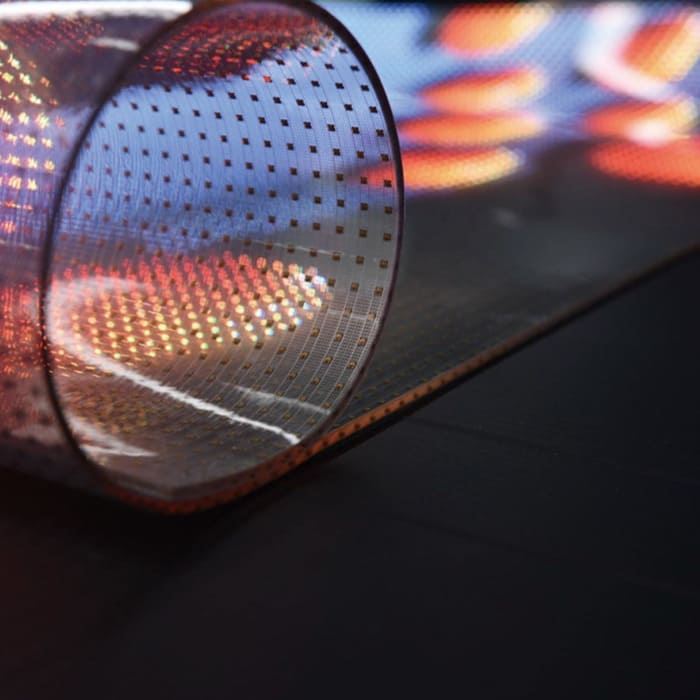Transparent LED film, also known as LED glass or adhesive LED film, is a cutting-edge technology that turns ordinary glass surfaces into dynamic digital displays.
Core Physical Features
- High Transparency: This is its defining characteristic. When turned off, the film is nearly clear, allowing for an unobstructed view through the glass. Transparency rates typically range from 70% to 95%, depending on the pixel pitch and design. This preserves natural light and views.
- Ultra-Thin and Lightweight: The film itself is extremely thin (often just a few millimeters thick) and very lightweight. This minimizes the load on the glass structure and maintains a sleek, almost invisible profile when not in use.
- Flexible and Adhesive-Based: Most transparent LED films are semi-flexible, allowing them to be applied to slightly curved glass surfaces. They come with a strong, pressure-sensitive adhesive layer for direct mounting onto glass, eliminating the need for bulky external frames or supports.
- Customizable Shapes and Sizes: Unlike rigid LED panels, the film can often be custom-cut into unique shapes and sizes (e.g., circles, curves, company logos) to fit specific creative design needs and architectural elements.
Technical & Performance Features
- Pixel Pitch (Resolution): This refers to the distance between the centers of two adjacent LED clusters (pixels). Common pitches for film are P3.9, P6.25, P7.8, P10, etc.
- Lower number (e.g., P3.9) = higher pixel density = sharper image, better for close viewing.
- Higher number (e.g., P10) = lower pixel density = more transparent, better for larger areas and longer viewing distances.
- High Brightness: These films are designed to be bright enough to overcome ambient light, especially when used in sunlit windows. Brightness levels can often be manually or automatically adjusted based on the time of day to save energy and avoid being overly glaring at night.
- Wide Viewing Angle: To ensure the content is visible to people walking or driving by from various angles, most transparent LED films offer a wide viewing angle, typically 140° to 160° both horizontally and vertically.
- Energy Efficiency: Compared to traditional LCD or LED video walls, transparent LED film is very energy-efficient. This is because it doesn’t require a bulky backlight system; the LEDs illuminate individually against the clear background.
- Easy Maintenance & Front Serviceable: Many advanced models are front-serviceable. If an LED module fails, technicians can replace it from the front side of the glass without needing access to the rear, which is crucial for installations on high-rise buildings or sealed environments.
Functional & Application Features
- Content Versatility: It can display everything from high-resolution videos and animations to static images and real-time data feeds (like social media feeds or news tickers). This enables interactive and engaging campaigns.
- Augmented Reality (AR) Potential: The transparent nature allows digital content to appear as if it’s interacting with physical products or people behind the glass, creating immersive “holographic-like” experiences.
- Simple Installation and Integration: The adhesive mounting makes installation relatively fast and minimizes construction work. It can be integrated with sensors and cameras to create interactive experiences where content changes when a person approaches (motion sensors) or touches the glass (touch sensors).

